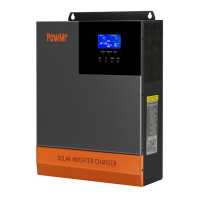How to clean PowMr POW-HPM Inverter heat sink?
- KKrystal WolfeAug 6, 2025
Ensure that the airflow around your PowMr Inverter is not blocked and remove any dirt or debris from the heat sink. It's recommended to conduct these checks twice a year.

How to clean PowMr POW-HPM Inverter heat sink?
Ensure that the airflow around your PowMr Inverter is not blocked and remove any dirt or debris from the heat sink. It's recommended to conduct these checks twice a year.
What to do if PowMr POW-HPM Inverter wires are damaged?
Inspect all exposed wires of your PowMr Inverter for damage caused by sunlight, friction, dryness, or pests. If necessary, repair or replace the damaged wires.
How to clean PowMr POW-HPM Inverter from dirt and corrosion?
Inspect your PowMr Inverter for dirt, nesting insects, and corrosion. Clean as required to maintain optimal performance.
Provides details on the POW-HPM series inverter's capabilities, charging, and output modes.
Illustrates the application scenario of the product and its system components.
Details the physical ports and indicators of the solar charge inverter unit.
Presents the physical dimensions and mounting specifications of the unit.
Highlights essential safety measures and precautions before and during installation.
Specifies wire diameters, circuit breaker types, and selection criteria for safe wiring.
Guides through the physical installation process and wiring connections.
Details the procedures and precautions for connecting multiple inverters in parallel.
Describes PV priority, Mains priority, hybrid, and only solar charging modes.
Explains PV priority, Mains priority, and battery priority output modes.
Details the LCD screen layout, operation buttons, and indicator lights.
Explains various configurable parameters and their settings for the inverter.
Lists parameters specific to different battery types, including lead-acid and lithium.
Explains the dry contact function for controlling generator charging.
Details RS485 and USB ports for communication with computers and modules.
Covers parallel communication and current sharing for multi-inverter systems.
Lists and describes all built-in protection functions of the solar charge inverter.
Provides a list of fault codes, their names, and descriptions for troubleshooting.
Offers solutions and remedies for specific fault codes and system issues.
